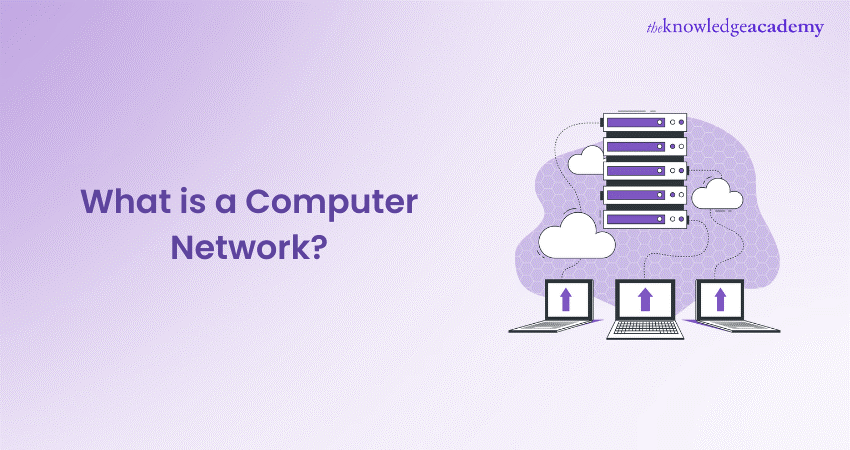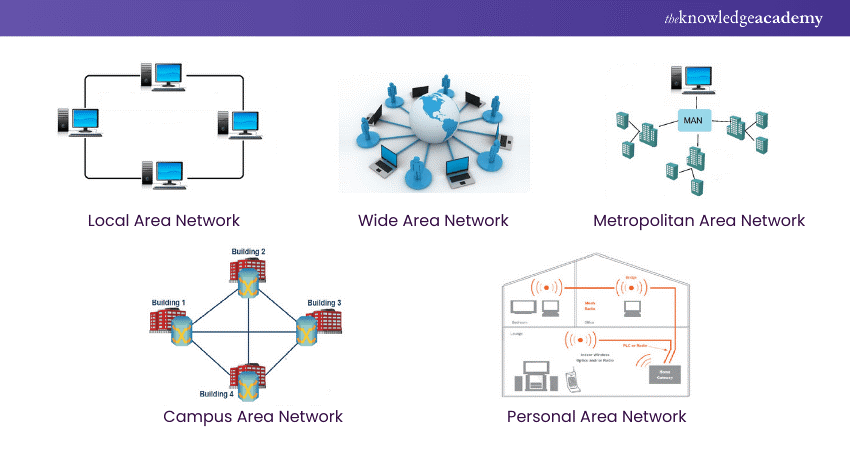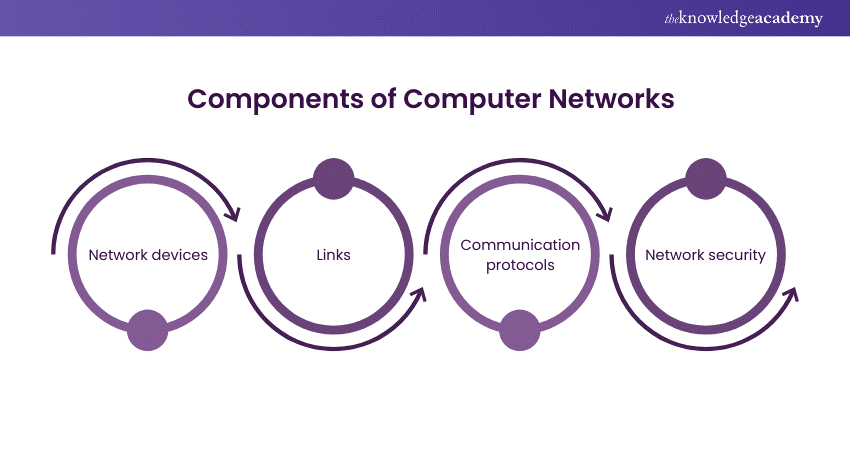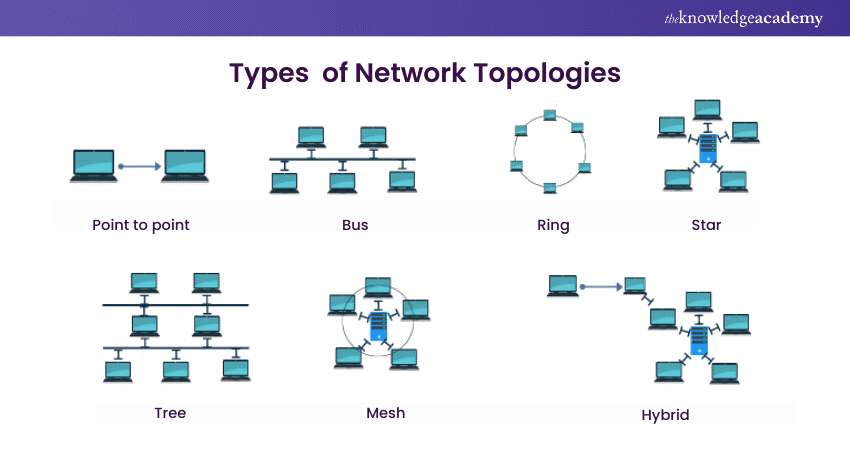We may not have the course you’re looking for. If you enquire or give us a call on 01344203999 and speak to our training experts, we may still be able to help with your training requirements.
Training Outcomes Within Your Budget!
We ensure quality, budget-alignment, and timely delivery by our expert instructors.

What is a Computer Network? Simply put, it is a system that connects two or more computing devices for transmitting and sharing information. Computing devices can range from a mobile phone to a server. They can be connected using physical wires such as fibre optics or wireless technologies such as Wi-Fi. The rules that govern how these connections work are called communication protocols.
Computer Networks have many benefits and applications in various fields, such as business, education, entertainment, and research. They allow users to access and share resources, communicate and collaborate, and exchange data and information. In this blog, we will explore What is a Computer Network in further detail, covering its types, components, workings and objectives.
Table of Contents
1) Defining Computer Networks
2) Key Objectives of Establishing a Computer Network
3) Types of Computer Networks
4) Components of Computer Networks
5) Network Topologies
6) Security in Computer Networks
7) The Internet as a Global Computer Network
8) Future Trends in Computer Networks
9) Conclusion
Defining Computer Networks
Let us begin by answering the basic question- What is a Computer Network? At its essence, a Computer Network is a complex system facilitating the seamless exchange of information between devices. These networks enable various electronic devices, from computers to smartphones, to communicate and share resources cohesively.
The foundation of Computer Networks lies in their ability to transcend geographical boundaries, allowing users to connect regardless of physical proximity. These networks can be as localised as a home network, connecting devices within a confined space, or as expansive as the global internet, bridging continents and cultures.
The pursuit of efficient communication, resource sharing, and collaborative innovation has shaped the evolution of Computer Networks. Networks empower individuals, businesses, and societies by providing a platform for real-time information exchange and collaboration. Whether through Local Area Networks (LANs) for internal office communication or Wide Area Networks (WANs) linking global entities, Computer Networks form the foundation of connectivity that defines our contemporary digital landscape.
How does a Computer Network work?
A Computer Network is a sophisticated web of interconnected devices, and understanding how it works involves understanding the basics of data transmission, protocols, and network devices. The process begins with data encapsulation, where information is wrapped in a standardised format for efficient transmission. Protocols, such as the Transmission Control Protocol (TCP) and Internet Protocol (IP), govern this communication, ensuring a common language across the network.
Routing plays a pivotal role in directing data through the network. Routers, the traffic controllers of the digital highway, analyse destination addresses and determine the most efficient path for data packets to reach their intended destination. Switches and hubs further facilitate this journey by managing the flow of information within local segments.
Essential network devices, including routers, switches, and hubs, collaborate to enable seamless connectivity. Routers connect different networks, switches facilitate communication within a network, and hubs serve as central points for data distribution. Each device contributes to efficient data flow, creating a dynamic network ecosystem.
Ultimately, a Computer Network operates as a collaborative orchestra, with each device playing a distinct role in ensuring that data travels swiftly and accurately from source to destination. This orchestrated symphony of protocols and devices forms the backbone of our interconnected digital world, enabling the instantaneous exchange of information that defines modern communication and collaboration.
Key Objectives of Establishing a Computer Network
In Computer Networks, establishing connectivity goes beyond mere technological interlinking; it revolves around achieving objectives that enhance overall system efficiency and foster collaboration. Here are the key objectives:
1) Shared resource utilisation
One of the primary objectives of a Computer Network is the efficient utilisation of shared resources. These resources can include hardware components like printers, scanners, and storage devices. By interconnecting devices, networks enable multiple users to access and use these resources simultaneously, optimising their utilisation.
2) Ensuring resource accessibility and reliability
Networks are designed to ensure seamless resource accessibility, promoting data retrieval and utilisation reliability. Whether accessing files on a shared server or utilising a centrally connected printer, the objective is to guarantee that resources are readily available and dependable for all network users.
3) Efficient performance oversight
Computer Networks incorporate mechanisms to monitor and manage network performance. This involves tracking data transfer speeds, identifying potential bottlenecks, and ensuring consistent performance across the network. Efficient oversight contributes to a smooth and responsive network experience.
4) Economical operations
Networks aim to streamline operations by reducing redundancy and optimising resource usage. This objective aligns with cost-effectiveness, ensuring the network infrastructure operates efficiently without unnecessary expenditures. Consolidating resources and centralising management contribute to economical network operations.
5) Expanded storage capability
Networks provide expanded storage capabilities through centralised servers and cloud solutions. This objective addresses the growing need for scalable storage solutions, allowing organisations to accommodate increasing data volumes without resorting to individual device upgrades.
6) Enhanced collaboration and communication streamlining
A fundamental goal of Computer Networks is to enhance collaboration and streamline communication. Shared access to files, collaborative document editing, and real-time communication tools are integral. The network acts as a facilitator for efficient teamwork, breaking down geographical barriers.
7) Error minimisation
Networks incorporate error detection and correction mechanisms to minimise data transmission errors. Robust protocols and algorithms ensure data integrity during transmission, contributing to the reliability and accuracy of information exchange.
8) Secure remote access
Enabling secure remote access is a crucial objective, especially in the modern work landscape. Networks implement security protocols to safeguard data during remote access, allowing users to connect securely to the network from different locations.
Types of Computer Networks
Computer Networks come in diverse forms, each tailored to specific needs and scale. The array of Types of Computer Networks can be categorised based on their geographical scope and purpose.

1) Local Area Networks (LANs)
LANs are confined to a limited geographical area, such as a single building or campus. They facilitate high-speed data sharing among devices like computers and printers, fostering seamless collaboration within a specific locale.
2) Wide Area Networks (WANs)
WANs cover larger geographical expanses, often connecting LANs across cities or countries. The internet is a global WAN, exemplifying how these networks enable communication and resource-sharing over considerable distances.
3) Metropolitan Area Networks (MANs)
MANs bridge the gap between LANs and WANs, covering a metropolitan area like a city. They offer connectivity for organisations with multiple locations within a city, facilitating efficient data exchange.
4) Personal Area Networks (PANs)
PANs are the smallest in scale, connecting devices like smartphones and laptops within an individual's personal space. Technologies like Bluetooth and Wi-Fi enable PANs, supporting seamless communication between personal devices.
5) Campus Area Networks (CANs)
CANs interconnect LANs within a specific academic or corporate campus. They provide a cohesive network infrastructure for institutions with multiple buildings, ensuring effective data transfer and communication.
Components of Computer Networks
A Computer Network comprises several critical components, each playing a distinct role in shaping the network's functionality, efficiency, and security.

1) Network devices
Network devices are the backbone of any Computer Network, facilitating communication and resource sharing. These devices include routers, switches, hubs, and access points. Routers direct data between different networks, while switches manage data flow within a network.
Though less common today, Hubs serve as central points for connecting devices. Access points enable wireless connectivity. Collectively, these devices create a cohesive network infrastructure that enables seamless communication and resource utilisation.
2) Links
Links form the physical or logical connections between network devices. Physical links involve cables, such as Ethernet or fibre optics, directly connecting devices. Logical links, on the other hand, are established through protocols and address assignments, creating a virtual connection. The quality and speed of links significantly impact the network's overall performance.
3) Communication protocols
Communication protocols are rules governing data exchange between devices on a network. Protocols define how data is formatted, transmitted, received, and acknowledged. Common protocols include Transmission Control Protocol (TCP), Internet Protocol (IP), and Hypertext Transfer Protocol (HTTP). Adhering to standardised protocols ensures interoperability among diverse devices and systems, fostering efficient and secure communication.
4) Network security
Network security is important as it protects data and resources from unauthorised access, attacks, and breaches. This includes implementing firewalls, encryption mechanisms, and intrusion detection systems.
Security protocols such as Secure Sockets Layer (SSL) and Virtual Private Network (VPN) are crucial in securing data during transmission. Robust network security ensures the integrity, confidentiality, and availability of information, safeguarding the network against potential threats.
Unlock the realm of VPN with our VPN Training – Sign up today!
Network Topologies
Network Topologies define the physical or logical layout of interconnected devices in a Computer Network, influencing communication, scalability, and fault tolerance. Several common Network Topologies are employed based on specific requirements and considerations:

1) Point-to-Point Network Topology
Two devices are directly connected in a point-to-point network, creating a dedicated communication channel. It's a simple and efficient setup used in telecommunications, providing a direct link for data exchange.
2) Bus Topology
In a bus topology, devices share a single communication line or "bus." Data travels along this central cable, and each device on the network receives the data. While simple and cost-effective, bus topologies can experience performance issues as the number of connected devices increases.
3) Star Topology
Each device is connected directly to a central hub or switch in a star topology. The hub acts as a central point for data exchange. Star topologies offer easy scalability and efficient fault isolation since the failure of one connection doesn't affect others. However, they may require more cabling.
4) Ring Topology
In a ring topology, devices form a closed loop, and data travels in one direction. Each device is connected to precisely two neighbours. While this structure simplifies network management, a failure in any single connection can disrupt the entire network.
5) Tree Topology
Tree topology is a hierarchical network structure where devices are arranged in a tree-like format. A central hub connects multiple secondary hubs or devices, forming a branching structure. This design enhances scalability and allows for efficient data flow and network expansion.
6) Mesh Topology
Mesh topologies involve direct connections between every device, creating redundancy and multiple communication paths. This redundancy enhances fault tolerance, as data can take alternative routes if one path fails. However, the extensive cabling and setup complexity are considered.
7) Hybrid Topology
Hybrid topologies combine elements of two or more topologies to meet specific needs. For example, a network might incorporate aspects of both star and bus topologies. This approach allows organisations to tailor their networks to balance efficiency, scalability, and fault tolerance.
Explore the skills needed for CloudFare with our CloudFlare Training – Sign up today!
Security in Computer Networks
Security in Computer Networks is crucial to safeguarding data, ensuring privacy, and preventing unauthorised access or malicious activities. As networks become increasingly complex and interconnected, robust security measures are imperative to mitigate risks and protect sensitive information.
One fundamental aspect of network security is the implementation of firewalls, which act as barriers between a trusted internal network and untrusted external networks. Firewalls monitor and control incoming and outgoing network traffic based on predetermined security rules, preventing unauthorised access and potential cyber threats.
Encryption is another critical component, ensuring that data transmitted over the network is secure and confidential. Secure Sockets Layer (SSL) and Transport Layer Security (TLS) protocols, for instance, encrypt data during transmission, thwarting eavesdroppers and maintaining the integrity of sensitive information.
Network Intrusion detection and prevention systems (IDS/IPS) are vigilant guardians, monitoring network traffic for suspicious activities and promptly responding to potential threats. These systems play a crucial role in identifying and neutralising cyber threats in real time, enhancing the overall security posture of the network.
Regular software updates, patches, and security audits are essential practices to address vulnerabilities and fortify the network against emerging threats. User authentication mechanisms, such as strong passwords and multi-factor authentication, add a layer of defence by verifying the identity of individuals accessing the network.
The Internet as a Global Computer Network
The Internet is a monumental achievement in Computer Networks, evolving into a global phenomenon connecting millions of devices worldwide. It is a vast, interconnected network of networks facilitating seamless communication, information sharing, and collaboration on an unprecedented scale.
At its core, the Internet operates on distributed networking principles, where no single entity controls the entire infrastructure. This decentralised approach ensures resilience, scalability, and accessibility. The Internet amalgamates diverse technologies, protocols, and standards, enabling data transfer across many interconnected devices.
One of the fundamental components of the Internet is the World Wide Web (WWW), a system of interlinked documents and resources accessible via the Internet. The web is a user-friendly interface, allowing individuals to navigate and interact with content using web browsers.
The Internet's impact on global communication and information dissemination is immeasurable. It has transformed how individuals access information, conduct business, and communicate across geographical boundaries. Social media platforms, online collaboration tools, e-commerce, and digital communication channels have flourished within this expansive digital ecosystem.
The Internet has also played a pivotal role in shaping the digital economy, fostering innovation, and providing a platform for diverse online services. From email communication to cloud computing, the Internet is the backbone of the modern digital landscape.
As the Internet continues to evolve, emerging technologies like the Internet of Things (IoT), artificial intelligence, and 5G connectivity further extend its capabilities. The Internet's global reach and transformative influence underscore its significance as a dynamic and ever-expanding global Computer Network that transcends borders and connects individuals, businesses, and communities worldwide.
Stay at the forefront of IT skills and fundamentals with our IT Fundamentals Training – Join today!
Future Trends in Computer Networks
The future of Computer Networks promises transformative trends that will reshape connectivity, communication, and information exchange. The integration of 5G technology is set to revolutionise network speed and responsiveness, facilitating a more connected and efficient digital ecosystem. Edge computing, leveraging decentralised processing power closer to end-users, will enhance real-time data processing and reduce latency.
The rise of Software-Defined Networking (SDN) and Network Function Virtualisation (NFV) heralds a shift towards more flexible, scalable, and programmable network infrastructures. Artificial Intelligence (AI) and Machine Learning (ML) will be pivotal in optimising network management, automating security protocols, and predicting potential issues.
Moreover, the Internet of Things (IoT) will continue to increase, expanding the network's scope to include many interconnected devices. Quantum computing holds the potential to revolutionise network security through advanced encryption methods. These trends collectively indicate a future where networks are faster, more intelligent, and seamlessly integrated into every facet of our digital lives.
Conclusion
We hope this detailed exploration of What is a Computer Network has answered your fundamental queries regarding its layers, types, and vital components. This blog has tried to demystify the essence of Computer Networks, highlighting their pivotal role in our interconnected digital world.
Gain insights into Networking with our Introduction to Networking Training – Join today!
Frequently Asked Questions

Computer Networks are essential for the digital world as they facilitate seamless communication, resource sharing, and collaboration. They connect devices globally, enabling efficient data transfer and access to information. Networks underpin the modern digital infrastructure, playing a pivotal role in the interconnected nature of our digital world.

Network components collectively contribute to functionality. Devices, like computers and routers, enable communication. Protocols establish rules for data transfer. Topologies define how devices connect. Security measures safeguard data. Their collaboration creates a robust system, ensuring efficient data flow, accessibility, and the overall functionality of Computer Networks.

Network security is crucial to safeguard against unauthorized access, data breaches, and cyber threats. It ensures the confidentiality, integrity, and availability of information in Computer Networks. Robust security measures, such as firewalls and encryption, protect against cyberattacks, providing a secure environment for data transmission and communication.

The Knowledge Academy takes global learning to new heights, offering over 30,000 online courses across 490+ locations in 220 countries. This expansive reach ensures accessibility and convenience for learners worldwide.
Alongside our diverse Online Course Catalogue, encompassing 17 major categories, we go the extra mile by providing a plethora of free educational Online Resources like News updates, Blogs, videos, webinars, and interview questions. Tailoring learning experiences further, professionals can maximise value with customisable Course Bundles of TKA.

The Knowledge Academy’s Knowledge Pass, a prepaid voucher, adds another layer of flexibility, allowing course bookings over a 12-month period. Join us on a journey where education knows no bounds.

The Knowledge Academy offers various IT Support and Solution Trainings, including Introduction to Networking Training and Security Management, Planning and Asset Protection Training. These courses cater to different skill levels, providing comprehensive insights into Importance of CCNA.
Our IT Infrastructure and Networking blogs covers a range of topics related to Computer Networks, offering valuable resources, best practices, and industry insights. Whether you are a beginner or looking to advance your Networking skills, The Knowledge Academy's diverse courses and informative blogs have you covered.
Upcoming IT Infrastructure & Networking Resources Batches & Dates
Date
 Introduction to Networking Training
Introduction to Networking Training
Fri 14th Jun 2024
Fri 12th Jul 2024
Fri 30th Aug 2024
Fri 13th Sep 2024
Fri 18th Oct 2024
Fri 29th Nov 2024
Fri 13th Dec 2024







 Top Rated Course
Top Rated Course



 If you wish to make any changes to your course, please
If you wish to make any changes to your course, please


